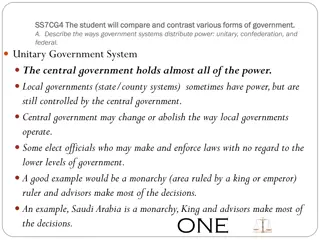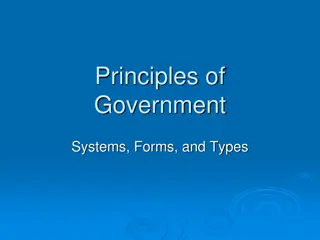Comparison of Government Systems: Unitary, Confederation, and Federal
The comparison of unitary, confederation, and federal government systems highlights how power is distributed between central and local authorities. In a unitary system, the central government holds most power, while local governments have limited autonomy. In confederation, local governments retain
0 views • 37 slides
Overview of Unitary, Confederal, and Federal States
Unitary, confederal, and federal states each have distinct characteristics regarding the distribution of power between central and subnational governments. Unitary states have centralized governance, while devolved states like the UK grant autonomy to subnational entities. Decentralized states trans
0 views • 22 slides
Understanding Departmental Accounts in Business
Departmental accounts are essential in business to evaluate the performance of various departments separately, compare results, reward managers based on performance, and formulate effective business policies. This accounting method offers insights into department affairs, aids in budgeting, and faci
1 views • 26 slides
Constitution of France: Salient Features of the Fifth Republic
The Constitution of France, in operation since 1958, aimed to bring stability after years of constitutional changes. It is rigid with complex amendment processes. France has a unitary constitution, a bicameral legislature, and a mix of presidential and parliamentary systems. The 5th Republic Constit
1 views • 25 slides
Analysis of EU Migrants Living in Wales Based on the 2021 Census Data
Comprehensive analysis of EU migrants living in Wales using data from the 2021 Census, highlighting key statistics such as country of birth, EUSS registrations, and distribution across different regions in Wales. Tables provide detailed insights into the presence of EU migrants in various Welsh unit
1 views • 8 slides
Features of China's 1982 Constitution
The 1982 Constitution of China, drafted after extensive discussions, adheres to socialist principles and emphasizes the socialist system as the foundation of the state. With a total of 138 Articles, it is a flexible document allowing for easy amendments and maintains a unitary system with centralize
2 views • 13 slides
Understanding Price Elasticity of Supply: Degrees and Concepts
Explore the concept of Price Elasticity of Supply (PES) through definitions, descriptions of elasticity degrees, and examples like perfectly inelastic, fairly elastic, and unitary elastic. Engage in an activity to deepen your understanding.
0 views • 5 slides
Understanding the Indian Federal System
The Indian federal system as defined by the Constitution of India establishes a unique structure where power is divided between the central government and the states. This system features characteristics such as governments at two levels, division of power, a written constitution, independent judici
2 views • 19 slides
Understanding Federalism in the United States
Explore the different types of governmental systems and the distribution of power between the federal and state governments. Learn about the advantages of federalism, how Texas utilizes federal funding, and the evolution of cooperation and coercion within the federal system over time. Dive into conf
7 views • 17 slides
Understanding Emergencies in the Indian Constitution
Dr. Babasaheb Ambedkar described the Indian Constitution as both federal and unitary, transitioning to complete unitary during crises. The Constitution allows for National, State, and Financial emergencies. Article 352 deals with National Emergency, where the President can proclaim it in case of war
0 views • 10 slides
Proportion Method for Scaling Ingredients in Cooking
Explore the unitary method for scaling ingredients in cooking for different numbers of people. Practice with examples to understand how to adjust quantities based on the number of individuals you are cooking for. Enhance your cooking skills with intelligent practice using the proportion method.
0 views • 7 slides
State Re-structuring and Federalism in Nepal by Resham Kandel
State restructuring in Nepal involves the redistribution of power across different tiers of government and the redesign of governance structures to achieve political, economic, social, and administrative transformation. The concept focuses on decentralization, inclusivity, and proportional represent
0 views • 26 slides
Comparison of Unitary and Federal Government Systems
This presentation compares unitary and federal government systems, highlighting differences in the number of governments, constitution type, flexibility, division of powers, supremacy of constitution, judiciary independence, and legislative structure. It explains how unitary governments have a singl
0 views • 7 slides
Understanding Presidential Control and Executive Power in the United States
In this detailed content, various aspects of presidential control over agencies, the executive power vested in the President, the Appointments Clause, and the concept of the Unitary Executive in the U.S. government are explored. The text delves into how the President appoints and removes officers, t
1 views • 36 slides
Understanding Forms of Government Today
Different forms of government exist in the world today, classified based on characteristics like participation, power distribution, and branches of power. Democracies emphasize people's involvement, while dictatorships concentrate power. Governments can be unitary, federal, or confederate, and power
5 views • 17 slides
Understanding Degrees of Elasticity of Demand
Elasticity of demand refers to the responsiveness of quantity demanded to changes in price. Perfectly elastic demand occurs when there is an infinite demand at a particular price and demand becomes zero with a slight rise in price. Conversely, perfectly inelastic demand occurs when there is no chang
0 views • 11 slides
Exploring Ratios and Proportions in Year 9 Mathematics
Dive into the world of ratios and proportions with Dr. J. Frost's engaging exercises and puzzles for Year 9 students. Explore concepts such as direct proportion, unitary method, and solve problems involving fish tanks, polygons, and more. Strengthen your understanding of mathematical relationships t
0 views • 11 slides
Comparison of Unitary, Confederation, and Federal Government Systems
The unitary government system centralizes power in the central government, confederation delegates power to local governments, and federal shares power between levels of government. Examples like Saudi Arabia (unitary), confederation (decentralized power), and the USA (federal) showcase these system
0 views • 36 slides
Principles of Government Systems and Types Explained
Explore the fundamental features of different government systems such as unitary, confederal, federal, autocratic, oligarchic, democratic, presidential, and parliamentary. Learn about the various forms of government, theories on the origin of states, and key characteristics of democratic government
0 views • 21 slides
Understanding Market Analysis and Valuation in Real Estate
Explore essential concepts in real estate market analysis and valuation, including the unitary valuation principle, net lease drugstore market trends, the importance of location, fee simple ownership, and leased fee valuations. Gain insights into the economic principles governing highest and best us
0 views • 65 slides
Understanding Government Systems and Divisions of Power
Explore the various divisions of power in government systems worldwide, with a specific focus on the U.S. Understand the concepts of federal, unitary, and confederation states, and learn about the structure of the U.S. government with its separation of powers and checks and balances. Discover how ge
0 views • 17 slides
Understanding Accountability and Power in Organizational Dynamics
Accountability is the obligation of individuals to report to their superiors about their work performance and outcomes. It cannot be delegated, always flows upward, remains unitary, and has specific standards. Power, on the other hand, is the capacity to influence others' behavior and may not always
0 views • 11 slides
Understanding Legislatures: Types, Functions, and Processes
Explore the structure and functions of legislatures, including the types such as unicameral and bicameral, unitary and federal legislatures, and the key functions like representation, legislation, financial control, and policy formulation. Delve into the law-making process and the role of parliament
0 views • 14 slides
Centralization vs Decentralization: A Comparative Analysis
This lecture delves into the dynamics of centralization and decentralization in subnational politics, exploring the benefits of each system, differences between federal and unitary government structures, challenges in reconciling territorial differences, reasons for the increasing popularity of cent
0 views • 15 slides
Understanding the Federal Features of the Indian Constitution
The Indian Constitution exhibits a unique blend of federal and unitary characteristics, termed as quasi-federal. This constitutional setup grants power to both the center and states, yet allows for central intervention in certain circumstances. The Parliament holds authority over creating new states
0 views • 4 slides
























